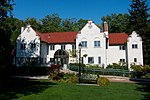Port Credit is a neighbourhood in the south-central part of the City of Mississauga, Ontario, Canada, located at the mouth of the Credit River on the north shore of Lake Ontario. Its main intersection is Hurontario Street and Lakeshore Road, about 0.6 kilometres (0.37 mi) east of the river. Until 1974, Port Credit was an incorporated town. Its approximate boundaries are the Canadian National Railway to the north, Seneca Avenue to the east and Shawnmarr Road to the west. It had a population of 10,260 at the 2001 census.
Port Credit was originally a settlement of the Mississauga Ojibwe First Nations band and a trading post established in 1720 for the exchange of goods from the Europeans for furs trapped by the Mississaugas. After the War of 1812, a harbour was established by the Mississaugas together with European and Jamaican settlers. In 1847, the Mississaugas left the village to relocate on the Six Nations Reserve to be with other band members and first nations. Industry was established on the village periphery including an oil refinery, but the neighbourhood is no longer a substantial industrial district. The village survived into the 20th century, becoming an independent municipality in 1909, until it was merged with the City of Mississauga in 1974.
Today, the original core village is now a heritage conservation district. The harbour is mostly used for recreational boating.
In recent years, the population of Port Credit has increased significantly from condo developments as well as gaining summer attraction from other Mississauga neighbourhoods. On the old site of an oil plant at Mississauga Road and Lakeshore, a massive condo complex named Brightwater has been planned to accommodate over 15,000 residents. The complex will include shopping, groceries and a college campus. Protests have taken place due to concern over the ratio of the size of Port Credit to the amount of traffic it will bring.








